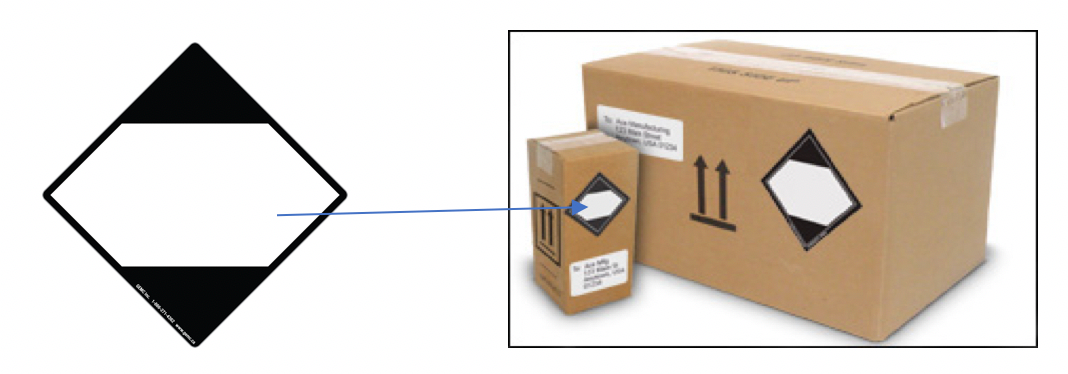
What Is Limited Quantity In ADR
27th Feb 2019
What Is Limited Quantity In ADR?

When it comes to transporting dangerous goods, one of the most frequently used signs is the limited quantity label, also referred to as the limited quantity mark in ADR regulations. At BseenBsafe, we stock two sizes of limited quantity labels, the smaller of the two is an LQ Packaging Label and the larger for vehicles, trailers, and containers we supply a Transport LQ Label sometimes referred to as a LQ Placard.
The purpose of these labels is to ensure proper identification when carrying hazardous goods in limited quantities. But what are limited quantity goods and how important are limited quantity labels?
WHAT DOES LIMITED QUANTITY MEAN?
Limited quantity labels feature a white diamond shape with a black outline. Limited quantity refers to any dangerous goods in limited quantities or limited quantities goods shipped in small containers and packed in boxes or shrink-wrapped trays.
Transporting hazardous goods in limited quantities generally means less risk. While there’s a chance regular hazardous goods labels won’t be necessary, the goods still need to be identified with a limited quantity label, and certain marking and documentation rules still apply even though not all detailed packaging requirements for fully regulated dangerous goods are needed.
For road (ADR) transport, all packaging group 1 dangerous goods are forbidden. Smaller quantities of packaging groups 2 and 3 substances can be transported as LQ, provided they meet LQ criteria, including maximum inner receptacle size, maximum gross mass, maximum box weight, and maximum gross overall package limits.
The packaging must use outer packaging, and combination packaging consisting of certified outer containers and suitable inner packaging is often used for compliance. Combination packaging, such as boxes with inner bottles or trays, is common for these shipments.
When comparing LQ and EQ (Excepted Quantities), note that EQ is also a standalone provision and includes air mode and air mode journey in its scope, with more prescriptive rules for packaging testing and documentation than LQ.
LQ exemptions do not remove all regulatory requirements—remaining obligations such as proper marking, documentation, and some safety measures still apply. When using small load or package small load exemptions, eligibility depends on transport categories, different transport categories, load limit, small load threshold, aggregation rules, mixed loads, and packages count, as outlined in ADR. These factors determine whether exemptions apply and what requirements remain for certain transport units.
Goods in limited quantities, dangerous goods in limited, and limited quantities goods must be packaged according to ADR, considering the same substance in different concentrations or forms, which may affect classification and packaging requirements.
For clinical waste, items such as clinical waste, conventional clinical waste bag, and sharps containers can be transported under small load or LQ exemptions when properly packaged, often using combination packaging consisting of inner bags or containers within certified outer packaging.
Vehicle marking requirements may include orange plates for certain transport units, but these may be optional or not required if the load qualifies for small load or LQ exemptions.
Throughout the process, various transport elements and certain transport units are involved, each subject to specific ADR requirements depending on the nature and quantity of the dangerous goods being moved.
EXCEPTED QUANTITIES AND EXEMPTIONS
When transporting dangerous goods, understanding the difference between limited quantities (LQ) and excepted quantities (EQ) is essential for compliance and safety. Both concepts offer exemptions from certain ADR regulations, but they apply under different conditions and have their own specific requirements.
Limited Quantity Exemptions
Limited quantity exemptions are outlined in ADR 3.4 and are designed for small containers typically used in the retail distribution chain. These LQ packages are packed in boxes or placed on shrink wrapped trays, ensuring that even though the goods are hazardous, the risk is minimized by the small size of each inner packaging and the secure outer packaging. The principle behind limited quantities is that, when properly packed in a box or shrink wrapped tray, the goods can be transported safely with fewer regulatory requirements.
Excepted Quantity Exemptions
Excepted quantity exemptions are a relatively new concept for land transport but have long been used in air transport. EQ provisions now allow for the road and rail elements of journeys that include air mode, making them a standalone provision for many consignors of dangerous goods. EQ requires the use of combination packages—such as a small bottle inside a box—and is governed by codes (E0 to E5) found in column 7b of Table A, which specify the maximum size for inner packaging and the total net content allowed in the outer packaging.
Both LQ and EQ have specific packaging testing and documentation requirements. For limited quantities, packages must display the limited quantity label, and particular LQ marking requirements apply to ensure the goods are easily identified during transport. In contrast, excepted quantity packages must be marked with the EQ symbol, and transport documents must clearly state “dangerous goods in excepted quantities” along with the number of packages being shipped.
Small Load Exemptions
Small load exemptions relate to the total quantity of dangerous goods carried in packages by a transport unit, such as a van, lorry, or trailer. The transport category assigned to each substance determines the load limits or thresholds for these small load exemptions. While many substances are assigned a packing group, this does not always correspond directly to the transport category. It’s important to note that small load provisions do not apply to tankers or bulk carriage—these exemptions are strictly for packaged goods.
When transporting limited quantities of dangerous goods, you are not required to follow all the normal packaging and labelling regulations. For example, a dangerous goods safety adviser is not needed if you are only transporting limited quantities. The concept of limited quantities is specifically designed for certain dangerous goods, allowing them to be carried in small containers—like bottles—packed in boxes or on shrink wrapped trays. The maximum gross weight allowed is 30 kg for boxes and 20 kg for shrink wrapped trays, with the maximum size for each inner packaging depending on the type of dangerous goods. These limits and requirements are detailed in column 7a of Table A.
In summary, both excepted quantities and limited quantities provide important exemptions for the transport of dangerous goods, each with their own packaging, marking, and documentation requirements. Understanding these rules—including packaging testing, labelling regulations, and small load exemptions—is crucial for anyone involved in transporting limited quantities of hazardous materials safely and in compliance with ADR regulations.
HOW SHOULD LQ GOODS BE PACKED IN SHRINK WRAPPED TRAYS?
Limited quantity substances are packed with a limited quantity label such as an LQ packaging label. According to limited quantity regulations for ADR transport, packages do not need to feature PSN, UN numbers or hazard warnings on the box. LQ labels now replace these marks.
The label indicates packaging shipped in accordance with these regulations. Limited quality labels need to be a diamond-shaped symbol that measures 100mm by 100mm. It features a white background and black outlines.

WHEN SHOULD YOU USE LIMITED QUANTITY LABELS FOR LIMITED QUANTITIES?
There is a range of factors to consider before deciding whether hazardous materials can be shipped with limited quantity labels. This includes the type of substance, hazard class, the total weight of a package and the size of the inner receptacle.
You might need a limited quantity label for goods such as paints, adhesives, aerosols, and drain cleaners. Substances that have radioactive and explosive qualities are unlikely to be eligible because of their dangerous properties.
Weight is another important factor. You can apply limited quantity labels to boxes with an inner packaging weight of up to 5kg and an outer weight that does not exceed 30 kgs. The maximum weight for goods you are transporting on shrink-wrapped trays is 20kgs
GET YOUR ADR COMPLIANT LABELS TODAY
BseenBsafe are unable to advise you on which signs you need for your vehicles or packages; your Dangerous Goods Safety Advisor is able to support you with this. All of our products comply with the British Standard BS5609 and meet the compliance of all relevant safety registrations. For more information on our limited quality labels get in touch via the contact form.

